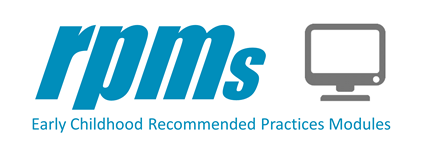Resource Search
Keyword Search
13 results found
Let's watch a parent-child interaction with a mother who is responding positively to her infant. Watch how the mother notices her child's interest in the piano. When the child begins vocalizing, she promptly replies, showing that she is paying attention to her child’s comments. The mother talks to her child about the piano, expanding on her child’s vocalizations. She helps her up so she can play the piano, extending her experience. She also plays with her, matching her child’s interest and enthusiasm.
In this video a mother notices her daughter’s subtle cues that she is interested in the puppet. She gazes at the puppet and her mother expands her experiences by encouraging her to play with the puppet.
Watch this video of a parent providing positive responses in her native language.
Watch this mother embed language and literacy into her interactions with her daughter using both Spanish and English. She has identified the target skill for her child as, naming parts of the face.
In this video notice how the teacher provides the child enough time to complete the target behavior of the student writing his name. She also uses explicit feedback - she said “See how well you did it... every letter.” It is clear to the child what the target skill was and that he did it correctly.
In this video a family is helping their child use sign language to request one of her favorite things, bubbles.
In this video look for prompts the teacher uses to support the child's engagement in the puzzle activity. Notice the teacher uses verbal cues and physical prompts by moving the puzzle piece closer to the correct position. She also uses sign language to prompt the child to help her with the puzzle.
In this video notice how the adults in this video provide reinforcing consequences for their children’s behavior through verbal and nonverbal responses.
In this video a child who enjoys blocks but isn’t able to lift them on his own. This parent has identified playing with blocks as a target skill. Look for the instructional supports in the video. The parent models how to play with the blocks, provides supports and accommodations so he can interact with them, and uses verbal reinforcement to encourage him when he uses the skill.
Watch this video of a family eating pizza. The mom is working on counting and embedding this target skill into an everyday activity, eating a meal.
In this video notice how caregivers use everyday activities to provide instruction to a child. This parent encourages her child’s speech by asking questions, waiting for her child to answer, and responding positively when she talks.
One way to support maintenance (or learning to do a skill after instruction has stopped) is to give children opportunities to continue to use their new skill while following their lead. Here are examples of adult’s following a child’s lead. These children are in their home environment.
Watch this video of a parent expanding her child’s opportunities. Notice how this mom encourages her child to use the phone and helps expand the activity by suggesting her daughter have a conversation with a relative.
